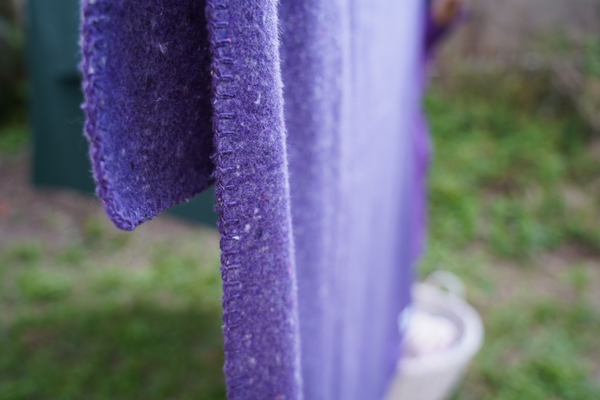
Wool is remarkably low maintenance and long-lasting for such a highly performing material. That’s why it’s worth taking care of.
As an active fibre, wool reacts to shifts in body temperature keeping you cool when it’s hot and toasty when it’s chilly. Its ‘wicking’ ability means merino fibre absorbs and evaporates large quantities of moisture, making it lightweight and warm, fast drying, breathable, insulating and odour resistant. Additionally, the natural oils in wool mean the material is naturally antibacterial and not easily stained. Wool is, in our opinion, totally amazing!
Protect and care for your wool items by paying attention to storage, maintenance and appropriate cleaning procedures. Here’s what to do to get the most out of your woollens.
How to wash wool without damaging or shrinking it?

Seljak Colour range Fig blanket airing out on clothes line.
Prolong the life of your wool garments and blankets by following these cleaning steps (they’re in order of least to most energy intensive):
- Air out your item by hanging it in the sun.
- Gently brush or vacuum the item with a brush attachment, to remove excess dirt, dust or lint.
- Spot clean marks and spills with lukewarm soapy water.
- Hand wash whole item using wool detergent in cold water and gently scrunch/massage the fabric, then rinse in clean water twice using the same motion.
- Machine wash if care instructions allow at a maximum temperature of 30 degrees.
- Do not tumble dry! Ideally air dry on a flat surface, to prevent stretching.
- Dry clean if necessary.
Although they are machine washable, the best way to prolong your Seljak Brand blanket is to hand wash or dry clean your blanket.
What laundry detergent is best for wool?
When endeavouring to wash wool items, we recommend purchasing a detergent that is formulated specifically for use with wool. Woolmark lists a selection of suggested detergents. Kin Kin Naturals and Saba Organics are two Australian-made options.

Kin Kin Naturals Wool & Delicates Wash is our favourite wool detergent.
How to dry wool?
We strongly advise against tumble drying your wool blanket or garments – unless the care tag specifically states otherwise! Instead, air drying naturally will save time and electricity. Take care to avoid direct sunlight or heat when drying, as it could cause colour damage.
We recommend flat drying over hanging, as the weight of the wet wool may cause the item to stretch and become misshapen. Flat dry wool items by placing them on a clean colourfast towel, or alternatively use a drying rack if you have space restrictions. When placing washed items out to dry, use your hands to gently shape it into size, removing visible creases or folds.

Lay woollen items flat to dry. We used beach towels underneath this blanket!


You’ll need a sponge, white vinegar, baking soda and a brush vacuum attachment (a soft bristle brush will also suffice).
1. Shake out your woollen item to remove dust.
2. Apply a thin layer of baking soda over the soiled wool, this should soak up any residue and hopefully prevent the fibres from binding. Leave the baking soda to sit for at least 30 minutes.

A light dusting of baking soda on the soiled area acts as a scent neutraliser.
3. Follow by vacuuming up leftover residue with a brush attachment.
4. Next create a cleaning solution of one part white vinegar and one part water.
5. Lightly soak a sponge in your cleaning solution, squeezing out excess liquid, keeping the sponge just slightly damp.
6. Begin spot cleaning the impacted area with your sponge, gently scrub in a circular motion. Pay attention to not saturate the wool, which may cause the fibres to bind.

7. Place your wool on a clean flat surface to dry, cover with a dry towel to assist soaking up any remaining moisture and leave it for at least 30 minutes.
8. Wipe off the impacted area with a sponge dipped in cold water and gently wring dry. Again, try not to saturate the wool!
9. Place the item next to a dehumidifier or simply hang on a clothes rack or flat dry in a well-ventilated space. Following drying, it should be free from odour.
10. If the smell persists, try washing it following the steps from the How to wash wool section.
What to do about pilling?

- Fabric comb
- Electric fabric shaver
- Sharp standard razor
Hold the item taut and gently shave off the pills. Collect the cut-offs with a lint roller or adhesive tape.


How to store wool?
In warmer months, store your Seljak blanket and other wool items in a cool, dry place, out of the sun. A sealed plastic container is best (vacuum bags are okay but might take the spring out of your blanket). Ensure the blanket is completely clean and dry when packed away, as moisture can eventually lead to mildew, and moths are attracted to grime. Airtight sealing protects against moths, which will want to lay eggs in your woollen items. If you own a cedar or camphor chest, wrapping the wool item in clean dry cotton before storing also works well.

If you’d like to add moth deterrents for extra protection, try natural options like clove, cedar or lavender which will leave your blankets smelling fresher than mothballs! Note the effectiveness of these reduces as their scent diminishes with time, so finding the right storage solution is the first port of call.
Woolmark is another great resource we recommend visiting for wool maintenance tips and tricks that we haven’t covered. Love and care for your wool items and in the long term, they will take care of you!

